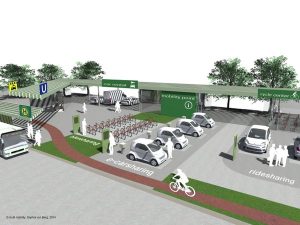I’ve lived in Kansas City my whole life. There are so many reasons why I love it; the food, the culture, the art, but I also see its flaws. Like every city, there are downsides to living here. A big downside that I not only see, but experience on a day to day basis, is the lack of transportation. Kansas City is a one mode city: the car. Yes, Kansas City has public transit; the bus and now, a streetcar; but these systems are not yet at a level that provides most of the Kansas City metro with “adequate” service. Most Kansas Citians do not live where they work.
The idea of mobility hubs is that certain intersections of our existing infrastructure could provide launch points for multi-modal transportation. These intersections could be two or more highways that cross each other, downtown city centers that provide multiple bus stops, etc. The key is using already built infrastructure, with good connections, to create a mobility hub that introduces a variety of transportation options (bus, rail, biking, and places to walk around) that better connect to the surrounding area; meaning close and long-range destinations.
The development of mobility hubs begins the conversation of prioritizing transportation, of all types, and to changing the streetscape. With the wave of autonomous vehicles and better transportation, these conversations need to be had. The future, inevitably, is not car-oriented. The future is consolidating transportation and making it more efficient, and hopefully, affordable. People look for walkability, convenience, and affordability; that is why mobility hubs matter. It’s another step closer to the future we want.

